Table of Contents
The Constitution of India, adopted on 26th November 1949, is the supreme law of the land. It lays the framework for the governance of the country, delineating fundamental rights, directive principles, and duties of citizens. It is a reflection of India’s aspirations for justice, liberty, and equality while embracing its diversity. This article explores its history, evolution, salient features, and key milestones in its creation.
What is a Constitution?
India, also known as Bharat, is a Union of States and a Sovereign Socialist Secular Democratic Republic with a parliamentary system. The Constitution of India, adopted on 26 November 1949 came into effect on 26 January 1950. The Constitution establishes a parliamentary government with a federal structure and some unitary features. The President is the constitutional head of the Executive. According to Article 79, the Parliament consists of the President and two Houses:
- the Rajya Sabha (Council of States) and
- the Lok Sabha (House of the People).
Article 74(1) states that there will be a Council of Ministers led by the Prime Minister to advise the President. The real executive power lies with the Council of Ministers, headed by the Prime Minister.
Difference Between Constitution & Law
The Constitution of a nation is the supreme law of the land whereas Law is a set of rules to govern social and government institutions, however, there is no precise definition of it.
| Constitution | v/s | Laws |
| They are the set of fundamental laws and guidelines that set down how a country should be governed. It is the supreme law of the land. | Definition | Law is commonly understood as a system of rules that are created and enforced through social or governmental institutions to regulate conduct. |
| The objective of the constitution is to establish a governance framework based on some fundamental and established core values | Objective | The objective of the law is to create a system of rules that are upheld by social and governmental institutions to regulate the conduct of society. |
| It provides for the coverage of the basic political code, framework, mechanism, power and obligation of the public institutions. It also provides fundamental rights, directive principles, fundamental duties etc. | Inclusion | Law includes the constitution, legal presiding, and related legislative rules and conventions. E.g., Right to Education, Right to Information, CrPC, IPC etc. |
| There are various types of constitutions as Monarchial, Republic, Parliamentary, Federal, Unitary, Political & Legal Constitution | Forms | Different types of laws are Criminal law, Contract law, Administrative Law etc. |
Read about: Important Articles of Indian Constitution
Purpose of Constitution
Rule of Law: Constitution establishes the doctrine of the Rule of Law at the place of the Rule of man. It is an important feature of a democracy, as in a democracy the power lies with the people.
Doctrine of Limited Government: it ensures that there should be legal constraints on the powers of government authorities, especially with respect to the rights of the people. It checks the arbitrary decisions of the authorities by providing the citizens with Fundamental Rights and an Independent Judiciary for its protection.
Ensure Fundamental Rights to its Citizens: As Fundamental Rights provided to the citizens ensure rule of law by limiting the arbitrary actions of the government. Hence, it provides political freedom to the citizens.
Doctrine of Separation of Power and Checks & Balance: It ensures the division of the functions of the three organs of the constitution and each checks and balances the functioning of other organs.
Independent Judiciary: Any constitution that wants to safeguard its citizens’ rights must protect and ensure the independence of the judiciary.
Read about: Preamble of Indian Constitution
Constitution Types
The Constitution helps check the country’s legal, political and social functions in different ways. Below are the types of constitutions:
| Type | Details |
| Codified Constitution | Almost all constitutions are “codified”, meaning they are written down clearly in a specific document called “the constitution”. |
| Uncodified Constitution | However, some countries, such as Israel, New Zealand and the United Kingdom, have “uncodified” constitutions, which means they are unwritten. |
| Procedural Constitution | Here, the constitution mentions government agencies’ legal and political structures and lays out the legal limits for government power to protect democratic processes and fundamental human rights. |
| Perspective Constitution | It provides a collective vision of what might be considered a good society based on a homogeneous community’s common values and aspirations. |
Read about: Constitution Day of India
Constitution Features
There are some important features that are typically contained in the Constitution:
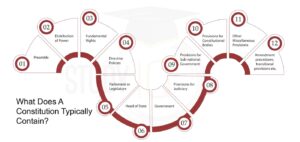
Constitution of India History
In 1600, the British arrived in India as traders in the form of the East India Company (EIC). Under a Charter granted by Queen Elizabeth I, the company had the exclusive rights to trading in India. Initially, they only engaged in trading and were not motivated by political gains. However, this scenario changed after their victory in the Battle of Buxar in 1764.
The company which until now was only engaged in trade gained Diwani rights (rights over revenue) of Bengal, Bihar and Orissa. This marked the rise of EIC as a territorial force. The company went on to administer India till 1858 when the British Crown directly assumed control of India’s affairs in the wake of the ‘Revolt of 1857’. The British government went on to rule India till its independence on August 15, 1947.
India’s independence necessitated a Constitution for the country. In 1946, the Constituent Assembly was formed to draft the constitution. The Indian Constitution came into being on 26th January 1950.
Read about: 42nd Amendment of Indian Constitution
Evolution of Indian Constitution
The evolution of the Constitution of India can be traced back to various acts and policies were undertaken by the Company and the British administration. The constitution of India came into force on January 26, 1950 under Dr BR Ambedkar (Farther of the Constitution of India) and transformed the Dominion of India into the Republic of India. It had been drafted, discussed, and finalised by the Constituent Assembly between 1946 and 1949. The evolution can be studied under two broad timelines:
- The Company rule (1773-1858)
- The Crown rule (1858-1947)
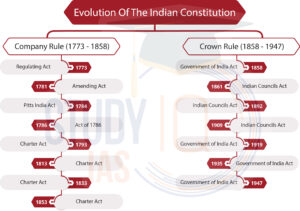
Constitution of India History – Regulating Act of 1773
Because the dual system set up by Robert Clive in 1765 was inefficient, the British Parliament decided to regulate the East India Company and passed the Regulating Act of 1773.
This was the first step to control the Company’s affairs and established a centralized administration in India by making the Governors of Bombay and Madras subordinate to the Governor-General of Bengal. For the first time, the political and administrative roles of the Company in India were officially recognized.
Constitution of India History – Pitt’s India Act of 1784
The Pitts India Act 1784 was passed by the British parliament to fix the flaws of the Regulating Act, of 1773. It was in continuation of the policy of decentralisation of administration which began by enacting the Regulating Act, of 1773.
It introduced the system of double government. A Board of Control was created for managing political affairs and the Court of directors was entrusted with managing only the commercial affairs of the company.
Constitution of India History – Charter Act of 1793
The Charter Act of 1793 was passed by the British Parliament to renew the charter of the East India Company. This act authorised the trade monopoly of the company with India for the next 20 years.
Constitution of India History – Charter Act of 1813
The Charter Act of 1813 was passed to renew the company’s charter for another 20 years. The company’s monopoly to trade in the east was severely opposed by the local British merchants including some parliamentarians. It ended the trade monopoly of the company except for trade in tea and trade with China.
Constitution of India History – Charter Act of 1833
Centralization of the Indian administration reached its zenith after the elevation of the Governor General of Bengal as the Governor-General of India. India’s first Law commission was constituted which was responsible for drafting the Indian Penal Code (IPC) which was enacted later in 1860.
Constitution of India History – Charter Act of 1853
The Charter Act of 1853 was the last charter act passed by the British parliament. It was the first step towards the inclusion of Indians in administration and law-making. The governor-general’s Council’s legislative and executive functions were separated for the first time.
A separate Indian (Central) legislative council was constituted which included 6 members as legislative councillors. The Indian (Central) Legislative Council was like a small Parliament (along the same lines as the British Parliament).
Constitution of India History – Government of India Act, 1858
The Government of India Act, 1858 is also known as the Act of Good Government of India. The act was enacted to transfer the powers of the government, administration, revenue and territories to the British crown. Its objective was to keep the Indian Government in check. However, no substantial changes were brought in the system of Governance which prevailed in India.
Constitution of India History – Indian Councils Act 1861
Indian Councils Act 1861 marked the beginning of representative institutions by associating Indians with the law-making process. It reversed the policy of centralisation under the Company’s rule which was started by the Regulating Act of 1773 and reached its climax under the Charter Act of 1833.
Constitution of India History – Indian Councils Act 1892
Indian Councils Act 1892: In a very limited sense, it initiated the principle of representation. As a result, the number of Indians increased in the legislative councils. This enabled leaders like Gopal Krishna Gokhale to enter the councils and enhance political consciousness among the masses.
Constitution of India History – Indian Councils Act 1909
Indian Councils Act 1909: Also called the Minto-Morley reforms Indians were given membership in the Imperial Legislative Council for the first time. This act legalised ‘Communalism’, and Lord Minto came to be known as the Father of Communal Electorate in India.
- The 1909 Morley-Minto Reforms were created by John Morley, the Secretary of State for India, and Lord Minto, the Viceroy of India.
- These reforms aimed to fulfill Queen Victoria’s promise of equal opportunity in governance.
- With help from Indian leaders, Morley successfully passed a resolution in the British Parliament.
- The Indian Councils Act 1909 allowed only a small number of educated and property-owning Indians to stand for elections.
In the 1910 legislative council elections, 135 Indians were elected as representatives. - The reforms increased the membership of the Imperial Legislative Council and provincial councils in Bombay, Calcutta, and Madras.
- They also introduced separate electorates for Muslims.
Important Features:
- Separate electorates for landlords and Muslims.
- Only one Indian member could be elected to the Viceroy’s executive council; Satyendra P. Sinha was the first.
- Introduced separate representatives for universities, zamindars, and chambers of commerce.
- Increased Indian representation in legislative councils at both provincial and central levels.
Constitution of India History – Government of India Act 1919
The Government of India Act of 1919 was based on a report by Edwin Montagu and Lord Chelmsford, which led to the Montagu-Chelmsford reforms in 1921. These reforms aimed to ensure that Indians could participate in their governance at both provincial and federal levels. The Government of India Act of 1919, also known as the Councils Act, aimed to increase Indian participation in government and established a Dual System of Government, dividing responsibilities between two types of governance.
Important Features:
Diarchy: This system was applied state-by-state, creating two governments: one responsible and one not.
Division of Subjects: Government activities were split into “central subjects” and “provincial subjects,” allowing easier control.
Legislative Changes: The Viceroy could introduce any bill, but the legislature needed his permission to pass bills.
Bicameralism: The Central Legislative Assembly had two houses: the Legislative Assembly (lower house) with 145 members, and the State Council (upper house) with 60 members.
Limited Interference: The Secretary of State for India and the Governor-General could intervene in certain areas, but their power was limited in others.
Governor’s Powers: The Governor controlled funds and could overrule ministers, but legislative proposals needed his approval.
Constitution of India History – Indian Independence Act of 1947
The Indian Independence Act of 1947 was a law passed by the UK Parliament that split British India into two independent countries, India and Pakistan.
It was approved on 5 July 1947 and received Royal Assent on 18 July 1947. India and Pakistan officially came into existence on 15 August 1947, which included what is now Pakistan and Bangladesh. The Act was based on the Mountbatten Plan, created by Louis Mountbatten, India’s last Governor-General, to transfer power from the British to the Indian people. This Act was the result of years of Indian struggle against British rule.
Historical Background of Indian Constitution
India is the largest democracy in the world, enjoying sovereignty and having the longest constitution, which includes 448 Articles (originally 395), 25 Parts (originally 22), 12 Schedules (originally 8), and 105 amendments (the first was made in 1950). The story of how the Indian Constitution was created is an important part of India’s history.
Government of India Act 1919: It announced that in 10 years from 1919, a royal commission will be set up to report on the working of the particular act, though the commission was appointed in 1928, even though it was to be appointed in 1929 as per the 1919 Act.
Indian Statutory Commission: Also came to known as Simon Commission’, was a group of seven Members of the British Parliament under the chairmanship of Sir John Simon. The commission arrived in India in 1928 to study constitutional reform in Britain’s largest and most important dominion. The purpose of this commission was to report on the working of the Indian established under the Government of India Act 1919 and to decide the political future of India.
Indians Response: The Indian National Congress along with the Muslim League boycotted the commission as a result of the protest Lord Birkenhead, the Secretary of State of India challenged Indian leaders to draft a Constitution for India which was accepted by the Indian leaders.
First Major Attempt: A committee was appointed with the task to draft Indian Constitution. The committee was under the leadership of Motilal Nehru with Jawaharlal Nehru as Secretary, Ali Imam, Tej Bahadur Sapru, Mangal Singh, M S Aney, Subhas Chandra Bose, Shuaib Qureshi and G R Pradhan where the other members. The draft of the constitution prepared by the committee was called the Nehru Committee Report or Nehru Report. The report was submitted in the Lucknow session of the all-party conference on August 28, 1928. This was the first major attempt by Indians to draft a constitution for India.
Demand of Constituent Assembly: The seed for the formation of the constituent assembly was sown initially in 1934 by the Pioneer of the Indian Communist Leader Mahendra Nath Roy (M.N Roy). Later, in 1935, the Indian National Congress (INC) officially demanded the setting up of a for framing the Constitution of India.
British Response: In early 1940, the British responded to the above demand and proposed August Offer this proposal included the establishment of an advisory war council, the inclusion of more Indians in administration, and recognized the right of Indians to frame their own Constitution after the end of the Second World War. The offer was, rejected by both Congress Working Committee and the Muslim League.
Cripps Mission: The Cripps Mission, headed by Sir Stafford Cripps, was sent in March 1942. It was entrusted with drafting a draft proposal on the framing of an independent constitution after the end of World War II. However, it also failed in its objective.
Cabinet Mission: In 1946, the Cabinet Mission came to India with the aim to discuss the transfer of power from the British Government to the Indian leadership, with the aim of preserving India’s unity and granting it independence.
It held discussions with representatives of British India and the Indian States to set up a Constituent body. And, also put forth a scheme for the formation of the Constituent Assembly. Based on the recommendation the Constituent Assembly was formed on December 1946.
Indian Constitution Timeline
Here is the Timeline of the formation of the Indian Constitution:
- 6 December 1946: Formation of the Constituent Assembly (following French practice).
- 9 December 1946: First meeting in the Constitution Hall; J.B. Kripalani spoke first, and Sachchidananda Sinha became temporary president. The Muslim League boycotted the meeting.
- 11 December 1946: Rajendra Prasad was appointed president, H.C. Mukherjee as vice-president, and B.N. Rau as legal adviser. Initially, there were 389 members, which decreased to 299 after partition.
- 13 December 1946: Jawaharlal Nehru presented the “Objective Resolution,” which later became the Preamble of the Constitution.
- 22 January 1947: Objective Resolution was unanimously adopted.
- 22 July 1947: The national flag was adopted.
- 15 August 1947: India gained independence, splitting into the Dominion of India and the Dominion of Pakistan.
- 29 August 1947: The Drafting Committee was appointed, with B.R. Ambedkar as chairman and six other members.
- 16 July 1948: V.T. Krishnamachari was elected as second vice-president of the Constituent Assembly.
- 26 November 1949: The Constitution of India was passed and adopted.
- 24 January 1950: Last meeting of the Constituent Assembly, the Constitution was signed and accepted, with 395 Articles, 8 Schedules, and 22 Parts.
- 26 January 1950: The Constitution came into force, taking 2 years, 11 months, and 18 days to complete, at a cost of ₹6.4 million.
G.V. Mavlankar became the first Speaker of the Lok Sabha after India became a republic.
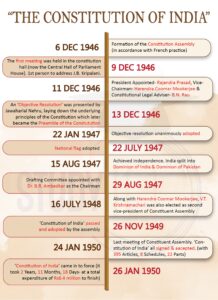
Indian Constitution Time Taken
Before the Constitution was made, Indian provinces were governed by the Indian Independence Act of 1947 and the Government of India Act of 1935. These acts were repealed when the Constitution began on January 26, 1950. The constituent assembly was formed in November 1946, and its first meeting took place in December 1946. Dr. B.R. Ambedkar chaired the assembly, which set up a drafting committee to create the Constitution for India.
It took about 11 sessions and 167 days, or exactly 2 years, 11 months, and 18 days, to complete the final draft of the Constitution, with around 2000 amendments.
Constitution Makers of India
India under British rule had two types of territories: British Provinces and Princely States. The constituent assembly was formed based on population, with one representative for every 10 lakh people.
There were 398 representatives in total:
- 296 from British Provinces and
- 93 from Princely States. However, since the Princely States did not participate, the assembly had 296 members from the British Provinces only.
The drafting committee of the Constitution had seven members namely
- Alladi Krishnaswami Ayyar,
- N. Gopalaswami,
- B.R. Ambedkar (Chairman of the drafting committee.),
- K.M Munshi,
- Mohammad Saadulla,
- B.L. Mitter,
- D.P. Khaitan.
Note: B.L.Mitter resigned due to health issues and he was replaced by N Madhav Rau. D.P. Khaitan died in 1948 and got replaced by TT Krishnamachari.
Conclusion
The Constitution of India is not just a legal document but a social contract that embodies the aspirations of its people. It is a testament to India’s resilience, adaptability, and commitment to democratic ideals. For UPSC aspirants, understanding the Constitution’s history, evolution, and features is crucial for developing a nuanced understanding of India’s polity.

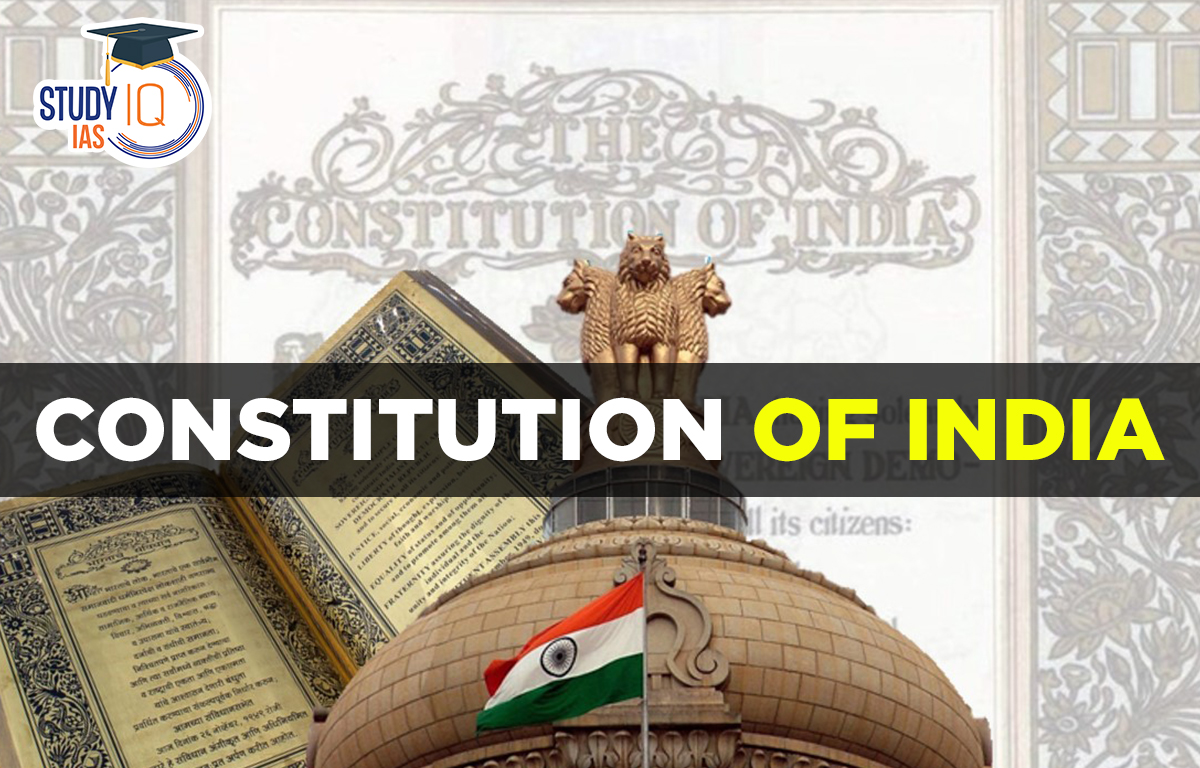
 Mechanisms to Combat Judicial Corruption...
Mechanisms to Combat Judicial Corruption...
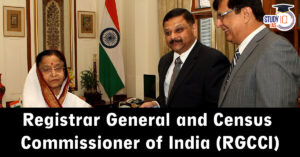 Registrar General and Census Commissione...
Registrar General and Census Commissione...
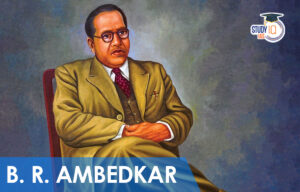 Ambedkar Jayanti 2025: Biography, Legacy...
Ambedkar Jayanti 2025: Biography, Legacy...





















